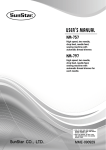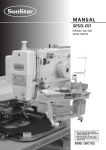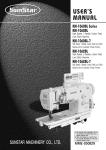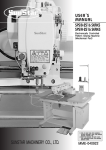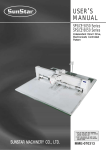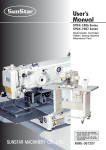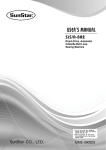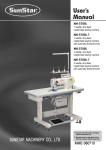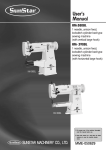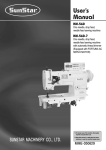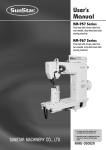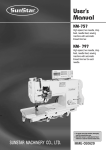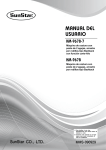Download User`s Manual
Transcript
R User’s Manual SPS/D-BR1254H Electronically Controlled Direct Drive Type Pattern Tacking Sewing Machine (Machine Structure Part) SUNSTAR MACHINERY CO., LTD. 1) FOR AT MOST USE WITH EASINESS, PLEASE CERTAINLY READ THIS MANUAL BEFORE STARTING USE. 2) KEEP THIS MANUAL IN SAFE PLACE FOR REFERENCE WHEN THE MACHINE BREAKS DOWN. MME-060214 lity a u tQ Besst Pricevice Be st Ser Be 1. Thank you for purchasing our product. Based on the rich expertise and experience accumulated in industrial sewing machine production, SUNSTAR will manufacture industrial sewing machines, which deliver more diverse functions, high performance, powerful operation, enhanced durability, and more sophisticated design to meet a number of user’s needs. 2. Please read this user’s manual thoroughly before using the machine. Make sure to properly use the machine to enjoy its full performance. 3. The specifications of the machine are subject to change, aimed to enhance product performance, without prior notice. 4. This product is designed, manufactured, and sold as an industrial sewing machine. It should not be used for other than industrial purpose. R SUNSTAR MACHINERY CO., LTD. Contents 1. Machine Type and Specifications .............................................................................. 6 1.1) Machine Type .................................................................................................................... 6 1.2) Specifications .................................................................................................................... 6 2. Safety Rules ......................................................................................................................... 7 2.1) Safety Marks ..................................................................................................................... 7 2.2) Machine Delivery .............................................................................................................. 8 2.3) Machine Installation .......................................................................................................... 9 2.4) Machine Operation ............................................................................................................ 9 2.5) Repair and Maintenance ................................................................................................. 10 2.6) Type of Safety Labels ..................................................................................................... 10 2.7) Location of Safety Labels ............................................................................................... 11 3. Assembly ............................................................................................................................ 12 3.1) Name of Machine Parts .................................................................................................. 12 3.1.1) Name of Machine Parts ....................................................................................... 12 3.2) Machine Installation ........................................................................................................ 13 3.2.1) Installation Environment ..................................................................................... 13 3.2.2) Electricity Environment ....................................................................................... 13 3.2.3) Table Installation .................................................................................................. 13 3.3) Machine Assembly ......................................................................................................... 14 3.3.1) Table Assembly ................................................................................................... 14 3.4) Accessory Installation ..................................................................................................... 16 3.4.1) Installation of Motor Cover ................................................................................. 16 3.4.2) Installation of Safety Plate ................................................................................... 16 3.4.3) Installation of Thread Stand ................................................................................ 16 3.5) Installation of Pneumatic Parts ....................................................................................... 17 3.5.1) Filter Regulator .................................................................................................... 17 3.5.2) Pneumatic Hose Connection ............................................................................... 18 4. Machine Operation ......................................................................................................... 20 4.1) Oil Supply ....................................................................................................................... 20 4.1.1) Supplying Location .............................................................................................. 20 4.2) Needle .............................................................................................................................. 20 4.2.1) Needle Installation ............................................................................................... 20 4.3) Thread .............................................................................................................................. 21 4.3.1) Upper and Lower Thread Placement .................................................................. 21 4.3.2) Threading ............................................................................................................. 21 4.3.3) Bobbin Case Insertion/Removal ......................................................................... 21 4.3.4) Tension Adjustment ............................................................................................. 22 4.3.5) Lower Thread Winding ....................................................................................... 23 4.3.6) Adjustment of Thread Winder Wheel Location ................................................. 23 4.4) Pedal Operation ............................................................................................................... 23 4.4.1) -20 Model .................................................................................................... 23 4.4.2) -22 Model .................................................................................................... 24 4.6) Pressured Air Infusion and Adjustment of Air Pressure ............................................... 24 4 4.6.1) Pipe Connection for Pressured Air ...................................................................... 24 4.6.2) Adjustment of Air Pressure ................................................................................. 24 4.7) Adjustment of Driving Belt Tension .............................................................................. 25 4.8) Upper Thread Holding Device (Optional) ..................................................................... 25 4.8.1) Adjustment of Upper Thread Holding Device ................................................... 25 5. Maintenance ...................................................................................................................... 26 5.1) Adjustment of Needle Bar Height .................................................................................. 26 5.2) Adjustment of Needle and Hook .................................................................................... 26 5.3) Adjustment of Feed Plate Height ................................................................................... 26 5.3.1) Adjusting Method ................................................................................................ 26 5.4) Adjustment of Presser Foot Height ................................................................................ 27 5.4.1) Adjusting Method ................................................................................................ 27 5.5) Adjustment of Presser Foot-related Devices .................................................................. 27 5.5.1) Adjustment of Presser Foot Driving Cam .......................................................... 27 5.5.2) Adjustment of Presser Plate Height .................................................................... 27 5.5.3) Adjustment of Presser Foot Adjusting Arm ....................................................... 28 5.5.4) Adjustment of Presser Foot Stroke ..................................................................... 28 5.6) Adjustment of Thread Release-related Parts .................................................................. 29 5.6.1) Thread Release Notch Position Setting .............................................................. 29 5.6.2) Thread Release Stopper Position Setting ............................................................ 29 5.6.3) Adjustment of Thread Guide Disk Opening ....................................................... 30 5.7) Adjustment of Trimming-related Parts ........................................................................... 31 5.7.1) Trimmer Cam Position Setting ............................................................................ 31 5.7.2) Adjustment of Link Stopper Screw ..................................................................... 31 5.7.3) Trimmer Shaft Position Setting ........................................................................... 32 5.7.4) Link Stopper Position Setting ............................................................................. 32 5.7.5) Adjustment of Moving and Fixed Blades ........................................................... 32 5.8) Adjustment of Bobbin Thread Volume .......................................................................... 33 5.9) Adjustment of Hand Pulley Device ................................................................................ 34 5.10) Assembly and Adjustment of Direct Drive Motor ...................................................... 34 5.10.1) Assembly of Coupling ....................................................................................... 34 5.11) X, Y Origin Setting ....................................................................................................... 34 5.11.1) X Origin Setting ................................................................................................. 34 5.11.2) Y Origin Setting ................................................................................................. 35 5.12) Oil Supply ..................................................................................................................... 36 5.12.1) Regular Check List ............................................................................................ 36 5.12.2) Oil Supply .......................................................................................................... 36 5.12.3) Oil Supplying Method ....................................................................................... 36 5.13) Cleaning ......................................................................................................................... 38 5.13.1) Cleaning Cycle and Method .............................................................................. 38 5.14) Handling of Waste Oil .................................................................................................. 38 6. Troubleshooting .............................................................................................................. 39 6.1) Machine Part ................................................................................................................... 39 5 1 Machine Type and Specifications 1.1) Machine Type Pattern Tacking Sewing Machine Type SPS / D- BR 12 ③ Purpose H : Heavy materials HC : Heat Cutter ① SunStar Pattern System ④ Pattern Tacking S/M Name 54 : 50×40mm 63 : 60×30mm ② Series Type D: Motor Direct Drive ⑤ Hook Type R : Rotary hook 1.2) Specifications Type SPS/D-BR1254HC Sewing Speed 2500spm Sewing Scope (X, Y) 50mm×40mm Stitch Length 0.1~10mm Feed Plate Lift 20mm Presser Foot Lift 41.2mm Needle DP17×#21, DP17×#23 DP17×#25, DP17×#26 Take Up Lever Stroke 72mm Hook Full Rotary 3-fold Capacity Hook No. of Stitch Input 10,000 Stitches No. of Basic Pattern Input 56 Patterns Memory EP RCM Zoom-in/out Scope 20~200% Motor AC Servo Motor 500W Power consumption 600VA Height of Presser Foot Air Cylingder Type Wiper Air Cylingder Type Presser Foot ○ ○ Secpmd Thread Tension × ○ Heat Cutter × ○ Power 6 SPS/D-BR1254H Free Voltage (110V/220V) 2 Safety Rules 2.1) Safety Marks The safety marks in this user’s manual are divided into Caution , Danger , and Warning . They indicate that if the safety rules are not kept, injury or damage to machine might occur as a result. No. Name Description Caution If the machine is not properly handled, it may cause injury to users or physical damage to the machine. Warning If the machine is not properly handled, it may cause death or severe injury to users. Danger If the machine is not properly handled, it may cause death or severe injury to users, and the urgency of the danger is very high. Caution Warning Danger 7 2.2) Machine Delivery Mark Description The machine delivery shall be conducted by the persons who are knowledgeable about the safety instructions and rules. The following safety rules must be observed: 2.2.1) Manual delivery When the machine is delivered by persons, they shall wear special shoes and tightly hold the machine on the left and right sides. Danger 2.2.2) Forklift delivery 1) A forklift shall be big enough to endure the weight of the sewing machine and carry the machine. 2) Use the palette when lifting the machine. Set the gravity center of the machine (center of the left and right sides) at the fork arm of the forklift and carefully lift the machine. Ban people from standing under the machine and remove obstacles near the machine. Warning 8 Make sure to maintain the balance of the machine when unloading the machine by using a forklift or crane to prevent the deformation of the machine or to prevent people from being exposed to danger. 2.3) Machine Installation Depending on the installation environment, function errors, breakdown, or other physical damage might result. Make sure to meet the following conditions for machine installation: Caution 1) The workbench or table where the machine is installed should be durable enough to endure the weight of the machine (see the name plate). 2) Dust and humidity are the cause of machine pollution and erosion. Please install an air conditioner and conduct regular maintenance of the machine. 3) Install the machine at the place where it is not exposed to direct sunlight (if the machine is exposed to direct sunlight for a long time, it may cause discoloration or deformation). 4) Secure the space around the machine. Place the machine at least 50cm away from the left, right, and rear walls to secure sufficient space for maintenance activities. 5) Explosion risk: To prevent possible explosion, immediately stop the machine operation if there are inflammable materials in the air. 6) Lighting: The machine does not offer lighting devices. When necessary, install needed lighting. 7) Overturn risk: Do not install the machine on the unstable stand or table. If the machine drops, it may cause injury or severe impact on the machine. If the machine is suddenly stopped or the external impact is imposed, the machine might be capsized. 2.4) Machine Operation The machine body is attached with Caution and Warning stickers at each dangerous part to emphasize safety instructions. With the full understanding of the safety instructions, make sure to observe the following during machine operation: Warning 1) Before turning on the power, read this manual thoroughly and have a full understanding of machine operation. 2) Get properly dressed. Long hair, necklace, bracelet, or wide sleeve might be fed into the machine during operation. Wear slip-free shoes to prevent slipping on the floor. 3) Check the moving scope of machine before its operation to find out whether the scope is proper. 4) Keep hands and head away from the machine parts where accidents might occur (needle, hook, thread take-up lever, pulley, etc.) during operation. 5) Do not remove the safety cover which protects pulley and shaft during machine operation for user’s safety. 6) Cut the power supply before disassembling the electric box such as the control box, and double-check that the power switch is“Off.” 7) Make sure that the power switch is“Off”when the upper shaft is manually rotated. 8) Stop the machine when the needle is replaced or when inspecting the machine after sewing work is done. 9) Make sure to follow the cautions below. Otherwise, physical damage to the machine such as malfunction and breakdown might result: - Do not put articles on the S/M table. - Avoid using a crooked needle or the needle with damaged tip. - Use the feed plate appropriate to working conditions. 9 2.5) Repair and Maintenance When machine repair is needed, it shall be conducted by SunStar A/S engineers only who have finished the due training course. 1) For cleaning and repair, cut off the main power supply. Wait for 4 minutes before starting maintenance to make the machine completely discharged. For main shaft motor and X,Y drive box, it takes 10 minutes before they are completely discharged after the main power is cut off. Danger Caution 2) Do not modify the machine specifications or parts without substantial consultations with SunStar. Otherwise, it may threaten safety during machine operation. 3) Use the parts manufactured by SunStar to repair or replace the machine parts during A/S service. 4) When repairing is completed, re-install all the removed safety covers. 2.6) Type of Safety Labels CAUTION 경 고 Do not operate without finger guard and safety devices. Before threading, changing bobbin and needle, cleaning etc. switch off main switch. 손가락 보호대와 안전장치 없이 작동하지 마십시오. 실, 보빈, 바늘교환시나 청소전에는 반드시 주전원의 스위치를 꺼 주십시오. Do not operate without finger guard and safety devices. Before threading, changing bobbin and needle, and cleaning, turn off the main switch. WARNING 경 고 Hazardous voltage will cause injury. Be sure to wait at least 360 seconds before opening this cover after turn off main switch and unplug a power cord. 고압 전류에 의해 감전될 수 있으므로 커버를 열 때는 전원을 내리고 전원 플러그를 뽑고 나 서 360초간 기다린 후 여십시오. 10 Hazardous voltage will cause injury. Be sure to wait at least 360 seconds before opening this cover after turn off main switch and unplug a power cord. 2.7) Location of Safety Labels CAUTION 경 고 Do not operate without finger guard and safety devices. Before threading, changing bobbin and needle, cleaning etc. switch off main switch. 손가락 보호대와 안전장치 없이 작동하지 마십시오. 실, 보빈, 바늘교환시나 청소전에는 반드시 주전원의 스위치를 꺼 주십시오. WARNING 경 고 Hazardous voltage will cause injury. Be sure to wait at least 360 seconds before opening this cover after turn off main switch and unplug a power cord. 고압 전류에 의해 감전될 수 있으므로 커버를 열 때는 전원을 내리고 전원 플러그를 뽑고 나 서 360초간 기다린 후 여십시오. 11 3 Assembly 3.1) Name of Machine Parts 3.1.1) Name of Machine Parts Motor Care Arm Thread Stand Emergency Stop Switch Safety Plate OP Box Power Switch Control Box Pedal 12 3.2) Machine Installation 3.2.1) Installation Environment 1) To prevent accidents stemming from mal-operation, do not use the machine if the voltage is 10% above the rated voltage. 2) To prevent accidents stemming from mal-operation, make sure to check if the air pressure is proper before using any air pressure devices such as air cylinder. To guarantee smooth operation of the product, the installation environment shall be prepared as described in User’s Manual. Otherwise, unexpected damage might occur to the product. Caution 3) Proper temperature during machine operation : 0°~ 40°C (32°~ 104°F) 4) Proper temperature during machine storage : -25°~ 55°C (-13°~ 131°F) 5) Humidity : Relative humidity – within 45 ~ 85% 3.2.2) Electricity Environment The voltage shall be within 10% of the rated voltage. Warning 1) Power voltage - The power voltage shall be within 10% of the rated voltage. - It is recommended to use the power frequency within +/- 1% of the rated frequency (50/60Hz). 2) Noise of electromagnetic wave - Do not share the power with the products which have either strong magnetic field or use high frequency. Make the machine stay away from the products mentioned above. 3) Take care not to spill water and coffee on the machine. 4) Do not drop Control Box and the motor to the floor. 3.2.3) Table Installation 1) Table fixing - Insert the shock absorbing rubber into the level adjuster and raise it until the caster freely moves. - After the table is installed, tighten the nut to fix the level adjuster. 2) Table height adjustment - Use the bolts attached to the table to adjust the height of the table to make sure that the users can smoothly and conveniently work. Bolt Nut Level Adjuster Shock Absorbing Rubber Caster 13 To prevent safety accidents, at least two persons shall be assigned to machine installation or machine delivery. Caution 3.3) Machine Assembly 3.3.1) Table Assembly 1) Install the waste oil can support, the oil dish, the control box, and the power switch on the table. Oil Dish Waste Oil Can Support Control Box Power Switch 2) Install the bed cushion rubber and the support rubber for safety switch to prevent the machine vibration and noises from occurring. Safety Switch Supporting Rubber Bed Cushion Rubber 3) To fix the machine, attach the hinge and the hinge rubber to the bed, and install them on the table by using fixing bolts. Fixing Bolt Hinge Rubber Hinge 14 4) Since the machine has not been fully assembled, take caution to lean the assembled machine toward the floor, and insert and fasten the bolt into the hinge to completely fix the machine to the table. Fixing Bolt To prevent safety accidents, at least two persons shall be assigned to machine installation or machine delivery. Caution 5) Install the safety switch and safety switch bracket on the sewing machine, and then adjust the bracket location of the safety switch to make sure that the attached safety switch can properly operate. Safety Switch Bracket Safety Switch Supporting Rubber Tightening Screw Safety Switch 6) Complete the cable connection between the machine and the control box, and fix the cables under the table as in the figure (Determine the length of the cables when fixing in consideration of the machine’s erection). Table 15 3.4) Accessory Installation 3.4.1) Installation of Motor Cover Fixing Screw Attach the motor cover to the rear side of the machine by using four fixing screws (4EA, small size). Motor Cover 3.4.2) Installation of Safety Plate Face Plate Attach the safety plate to the head. Safety Plate To guarantee safety, make sure to install the safety plate before using the machine. Caution 3.4.3) Installation of Thread Stand Assemble the thread stand and install it on the table. Make adjustment to properly locate the thread stand. 16 3.5) Installation of Pneumatic Parts 3.5.1) Filter Regulator Install the filter regulator on the right side of the table leg. Caution 1) Adjust the pneumatic pressure to 5~5.5kgf/cm (0.49~0.54MPa). 2) If the pneumatic pressure goes below 4kdf/cm, the error message appears, and at the same time the machine stops its operation [ Error message : Err 24 (Low Pressure!) ]. 3) When the finger valve is closed after use, the remaining air is automatically released, and the remaining pressure is displayed at 0Mpa (0kgf.cm). 17 3.5.2) Pneumatic Hose Connection 1) Pneumatic hose connection for all-in-one type feed frame (SPS/D-BR1254A-20 / BR1263A-20) ② ① 1. Connect the filter regulator with the solenoid valve using the hose①. 2. Insert the hoses labeled as“S3F, S4F”into the outlets of the solenoid as in the figure. Fully insert the hoses until they are not inserted. 3. Finish the hose connection by using the quick coupling②. 4. Lastly, connect the solenoid with the pressure switch connector to complete the assembly of this part. 18 2) Pneumatic hose connection for separate type feed frame (SPS/D-BR1254A-22 / BR1263A-22) ① 1. Connect the filter regulator with the solenoid valve by using the hose①. 2. Insert the hoses labeled as“S3L, S4L, S3R, S4R” into the outlets of the solenoid. 3. Lastly, connect the solenoid with the pressure switch connector to complete this assembly (make sure to connect the solenoid and proper connectors based on labels). 19 4 Machine Operation 4.1) Oil Supply 4.1.1) Supplying Location - In the first operation of the sewing machine, check the remaining volume of oil through the oil window and supply oil if it is found insufficient. 4.2) Needle 4.2.1) Needle Installation Loosen the needle fixing screw. With the long groove of the needle headed forward, insert the needle until the upper end of the needle touches the end of the hole, and fix the needle by using the needle fixing screw. Needle Fixing Screw Needle 20 4.3) Thread 4.3.1) Upper and Lower Thread Placement 1) Upper Thread Placement Place the thread take-up lever at the highest position, and pass the thread through the main and sub thread adjusting devices. H-type Upper Thread Placement H-type Upper Thread Placement 2) Lower Thread Placement Insert the bobbin into the bobbin case. Insert thread into the groove and pass it under the tension adjusting plate spring. 4.3.2) Threading Place the thread take-up lever at the highest position and then conduct threading. For heavy materials, conduct threading as in Fig. ①, and for general and light materials and knit, conduct threading as in Fig. ②. ① Heavy Materials ② General Materials 4.3.3) Bobbin Case Insertion/Removal Push the bobbin into the hook by holding the bobbin case handle until you hear a click sound. Caution If the bobbin case and the hook are not accurately assembled, thread might be entangled or the bobbin case might be ejected during machine operation. Make sure that the bobbin case is completely inserted into the hook before operating the machine. 21 4.3.4) Tension Adjustment 1) Adjustment of Upper Thread Tension Turn the tension adjusting nuts of the main and sub thread adjusting devices clockwise, and the tension of the upper thread will grow strong. If they are turned in the opposite direction, the tension of the upper thread will grow weak. Adjust the thread tension in accordance with the sewing conditions including sewing materials, thread, and number of stitches Sub Thread Adjusting Device Main Thread Adjusting Device 2) Adjustment of Thread Take-up Lever Spring Tension Adjust the tension of the thread take-up lever spring by turning the bolt on the main thread adjusting device axis with a drive. If the bolt is turned clockwise, the thread take-up spring tension is strengthened. Otherwise, the tension is weaker. (The standard movement volume is 6-8mm, and the standard tension is 30-50g.) 3) Adjustment of Lower Thread Tension If the bobbin case tension adjusting screw is turned clockwise, the lower thread tension grows stronger. If the bobbin case tension adjusting screw is turned counter-clockwise, the lower thread’s tension grows weaker. Stronger Weaker Tension Adjusting Screw 22 4.3.5) Lower Thread Winding 1) Press “Select” on OP Box and select the bobbin winder. 2) Insert the bobbin into the thread winding shaft on the thread winding base, which is attached to the top cover. 3) Attach the thread winding lever to the bobbin, and press the pedal to operate the machine. 4) After the thread winding lever is separated from the bobbin, use the thread winding blade to cut the thread of the bobbin. Adjust the thread winder wheel to be 1mm away from the presser foot driving cam and then fasten the tightening screw after the adjustment is completed. 1mm 4.3.6) Adjustment of Thread Winder Wheel Location Upper Shaft Thread Winder Drive Wheel Presser Foot Drive Cam 4.4) Pedal Operation 4.4.1) -20 Model 1) Install the pedal at the proper and most convenient place for users to work. 2) When the right pedal is pressed, the feed plate descends. When the pedal is pressed once again, the feed plate ascends. 3) If the left pedal is pressed after the feed plate descends, the sewing begins. When the sewing is finished, the feed plate ascends. Press the right pedal Press the left pedal 23 4.4.2) -20 Model 1) Use the right pedal to make the right feed plate ascend or descend. 2) Adjust the left pedal by step to regulate the movement of the left feed plate and sewing operation. - Step 1 : Adjust the left feed plate movement - Step 2 : Start the sewing (Provided that the right feed plate adjustment should be completed) 3) Regarding how to change parameter setting of the separate-type pedal, see page 18 of the Electricity and Electronics Manual. Press the right pedal Press the left pedal 4.6) Pressured Air Infusion and Adjustment of Air Pressure To prevent safety accidents from occurring, make sure that the power is off during this adjustment. Caution 4.6.1) Pipe Connection for Pressured Air - Connect the quick joint plug which is attached to the table with the quick joint socket where pressured air flows in. - Open the finger valve to let the pressured air flow in. [ Note ] When the finger valve is closed after use, the remaining air is automatically released, and the remaining air pressure is marked at 0 MPa(0 kgf/cm2). 4.6.2) Adjustment of Air Pressure Pull up the adjusting knob on the top of the filter regulator and turn it clockwise. Then the air pressure increases, and vice versa. This way, adjust the pressure to the appropriate level of 0.49~0.54 MPa (5~5.5 kgf/cm2) and then return the adjusting knob to the original place. 24 Finger Valve Hose Quick Joint Socket Flog 4.7) Adjustment of Driving Belt Tension 1) Disassemble the front arm cover. 2) When it is turned in the (+) direction, the tension increases. But when it is turned in the (-) direction, the tension decreases. 4.8) Upper Thread Holding Device (Optional) 4.8.1) Adjustment of Upper Thread Holding Device - Check whether the upper thread holder pin’s cylinder knuckle and cap are located in the middle of the upper thread path. - If not, loosen two fixing screws for the upper holder pin cylinder bracket and make adjustment to make the cylinder knuckle and cap located in the middle. When the adjustment is completed, tightly fasten the fixing screws. - The standard distance between the end of the knuckle cap and the arm is 4mm. - To adjust the distance, loosen the two pin cylinder nuts and make the back and front adjustment. When the adjustment is completed, tightly fasten the two nuts. 25 5 Maintenance 5.1) Adjustment of Needle Bar Height Tightening Screw DP×15 Place the needle bar at the lowest position, and loosen the needle bar holder screws. Find an upper carved line appropriate to the needle specifications, and make the line touch the bottom of the needle bar bushing. When the adjustment is completed, fasten the tightening screw for the needle bar holder. Less than DP×17 #22 DP×17 #22 or above 5.2) Adjustment of Needle and Hook Locate the needle bar at the lowest position. When the needle bar ascends, make the lower carved line appropriate to the needle used touch the bottom of the bushing. Needle Bar Lower Bushing DP×5 DP×17 #22 or above Less than DP×17 #22 5.3) Adjustment of Feed Plate Height 5.3.1) Adjusting Method To adjust the height of the feed plate, change the feed plate height according to the length of the cylinder shaft which is connected to the cylinder arm. Cylinder Shaft Length Feed Plate Height Increase Decrease Decrease Increase After completing the adjustment of the feed plate height, tightly fasten the cylinder knuckle fixing nut. Caution 26 5.4) Adjustment of Presser Foot Height 5.4.1) Adjusting Method - Loosen the fixing screw for the presser foot when the needle bar is at the lowest position. - Adjust the presser foot height by setting the distance between the bottom of the presser foot and the sewing materials to be 0.5mm (thickness of the thread used), and fasten the fixing screw. 0.5mm Tightening Screw Caution It is required to check the wiper after adjusting the presser foot height. – If the gap is too big, it may cause stitch skip. – If the gap is too small, it may cause bad thread adjustment. 5.5) Adjustment of Presser Foot-related Devices Tightening Screw 5.5.1) Adjustment of Presser Foot Driving Cam Make the end of the presser foot driving cam located at the center of the punched mark of the upper shaft. Make the adjustment to make the cam’s carved line and the upper shaft’s punched mark overlap, and then fasten the tightening screw. Punched Mark Upper Shaft If the presser foot driving cam is not properly located, the up/down movements of the presser foot do not have harmonious timing. It may cause clash between the needle bar and the presser foot. Caution 5.5.2) Adjustment of Presser Plate Height - Adjust the presser plate to make its end protruded from the presser plate handle by 17mm. Check whether the needle goes through the center of the presser foot. When it is confirmed, fasten the tightening screw. Presser Bar Presser Bar Handle Presser Foot Caution Fasten the tightening screw for the presser plate at the pressure of 40~45kgf/cm3. If the pressure is excessive during assembly, it may case deformation of the presser plate and obstruct proper operation of the machine. 27 5.5.3) Adjustment of Presser Foot Adjusting Arm - Loosen the screw for the location link stopper to make space between the location link stopper and the hinge screw for the presser foot driving link. - Loosen the screw for the fork link, and move the hinge screw for the presser foot link to the right side of the presser foot adjusting arm. Then tightly fasten the hinge screw for the presser foot link. - Turn the hand pulley to locate the needle bar at the lowest position. - Lift the presser bar to make the gap between the presser bar handle and the presser bushing 4mm wide, and tightly fasten the tightening screw for the fork link. - Turn the location link stopper screw to make the location link stopper and the hinge screw for the presser foot driving link closely contacted. - Tightly fasten the tightening screw for the fork link and ensure that there is no clearance in the vertical direction for the presser foot adjusting arm. Check the tightened conditions of screws, and adjust the presser foot stroke. Caution 1) If there is no space between the presser bar handle and the presser bar bushing, they may intervene in each other during machine operation. 2) If the screws are not tightly fastened after making adjustment, it may cause damage to the machine during operation. 3) If the hinge screw for the presser foot driving link does not closely contact the end of the location link stopper, the machine might vibrate and produce loud noises during operation. Hinge Screw for Presser Foot Link Tightening Screw Presser Foot Adjusting Arm Stopper Hinge Screw 4mm Presser Bar Handle Presser Bar Bushing 5.5.4) Adjustment of Presser Foot Stroke Loosen the hinge screw for the presser foot adjusting arm and move it in the (A) direction. Then the presser foot’s stroke gets larger. When it is moved in the (B) direction, the presser foot’s stroke gets smaller (the default setting is 4mm). 28 B A Hinge Screw 5.6) Adjustment of Thread Release-related Parts Tightening Screw 5.6.1) Thread Release Notch Position Setting Notch Move the notch to make the tightening screws touch the right side of holes on the notch, and fasten the notch by using the tightening screws. If the notch is not properly positioned, the remaining thread might be too short or irregular. When the sewing begins, the thread might exit from the needle. Caution 5.6.2) Thread Release Stopper Position Setting - Disassemble the thread release return spring. - Loosen the tightening screw for the thread release stopper and adjust the distance between the trimmer driving link and the thread release lever pin to be 0.3mm. If the thread release stopper is pushed to the right side, the distance between the trimmer driving link and the thread release lever pin grows narrower. If it is pushed to the left side, the distance between them grows wider. - Assemble the thread release return spring. Thread Release Lever Pin Trimmer Drive Link Thread Release Return Spring 0.3mm Thread Release Stopper Tightening Screw Wider Narrower To prevent safety accidents, please use proper tools to disassemble or assemble the thread release return spring. Caution 29 5.6.3) Adjustment of Thread Guide Disk Opening - Loosen the tightening screw for the thread release adjustment plate. - Conduct thread trimming to make the thread guide disk open. - Adjust the guide disk to be open 0.6~0.8mm for general materials and 0.8~1mm for heavy materials respectively. When the angle between the thread release adjustment plates is bigger, the opening of the thread guide disk increases. When the angle between the plates is narrower, the opening decreases. - When the adjustment is completed, fasten the tightening screws. If the opening is not proper, the remaining thread might be too short or irregular. The thread guide disk might not be completely closed. Caution Wider Narrower Opening Tightening Screw Thread Release Adjusting Plate Direction of Thread Release Link 30 Direction of Major Thread Adjusting Device 5.7) Adjustment of Trimming-related Parts 5.7.1) Trimmer Cam Position Setting Set the distance between the upper shaft collar and the trimming cam at 1.7mm. Move the trimming cam to make the carved line of the trimming cam touch the punched mark of the upper shaft and fasten the tightening screw. If the trimming cam is not properly positioned, the trimmer is not properly operated nor the parts might get stuck to each other. Caution Trimmer Cam 1.7mm Carved Line Punched Mark Upper Shaft Upper Shaft Upper Shaft Collar ① 5.7.2) Adjustment of Link Stopper Screw 1) With the needle bar at the lowest position, push the trimmer driving link toward the trimming cam around the moving section of the trimmer cam to check whether there is space between the trimmer cam roller and the ends of the trimmer cam. 2) While the trimmer cam roller is inserted into the moving section of the trimmer cam, adjust the end of the link stopper screw to meet the section (A) of the trimmer connecting rod, and fasten the nut. Caution 1) If there is not enough space between the trimmer roller and the both ends of the trimmer cam, the trimmer might not be properly operating or upon the beginning or end of sewing, parts might get stuck with each other. 2) If the location of the link stopper screw is not proper, it takes longer time to return to the original position after trimming and the first stitch’s sewing condition might not be good. Space Space Trimmer Drive Cam Roller Trimmer Drive Link Trimmer Cam Trimmer Connecting Rod Link Stopper Screw Link Stopper Screw Nut Trimmer Connecting Rod 31 5.7.3) Trimmer Shaft Position Setting 1) Loosen the tightening screw for the trimmer driving link and the tightening screw for the trimmer shaft collar. 2) Make the cross-section of the trimmer shaft touch the A section of the arm. 3) Fasten the tightening screw. Trimmer Cam Trimmer Drive Link Trimmer Shaft Tightening Screw If the position is not properly set, the trimmer operation might be faulty or the parts might be stuck with each other. Caution 5.7.4) Link Stopper Position Setting Tightening Screw 1) While the trimmer is not in operation, loosen the tightening screw for the trimmer driving link stopper and set the distance between the trimmer driving link and the trimmer driving link stopper’s notch to be 0.3mm. 0.3mm Trimmer Drive Link 0.3mm Trimmer Drive Link Stopper If the position is not properly set, the trimmer operation might be faulty or the parts might be stuck with each other. Caution 5.7.5) Adjustment of Moving and Fixed Blades 1) Adjustment for H type machine For the adjustment of the needle hole guide and the distance between A and B of the moving blade, see the table below. - Adjustment of the blade distance“A” Loosen the fixed blade screw and adjust the space of the fixed blade - Adjustment of height gap“B” If the heights of the fixed blade and the needle hole guide are not identical, bend the moving blade to adjust the heights. - Adjustment of distance between needle plate and fixed blade Adjust the distance between the needle plate and the fixed blade to be 0.3~0.5mm. 0.3~0.5mm H Type Size of A 0.8~1mm Size of B 0.25~0.35mm If the size of A is smaller or the size of B is larger, either upper thread or lower thread would be short. Caution 32 0.5mm 2) Adjustment for HC type - Adjustment of distance between blades Loosen the fixing screw for the fixed blade and adjust the fixed blade base to set the distance between the needle plate cover and the fixed blade to be 0.5mm. Fixing Screw Caution 1. After completing the distance adjustment, use the testing device to test whether there is an electric short circuit among the fixed blade, the needle plate cover, and the needle plate (If there is a short circuit, it may cause bad trimming and machine breakdown). 2. The tightening pressure of the fixing screw① should be set at 9.8~14.7N/cm (10~15kgf/cm). 5.8) Adjustment of Bobbin Thread Volume Bobbin To adjust the thread volume wound on the bobbin, use the initial position of the thread winder adjusting plate. If lots of thread is wound, loosen the tightening screw on the thread winder adjusting plate and turn it to the A direction. If the thread volume wound on the bobbin is small, turn the screw in the B direction. Thread Winder Adjusting Plate Upper Shaft Thread Winder Drive Wheel 1mm - Adjust the thread winder wheel to be 1mm away from the presser foot driving cam and fasten the tightening screw. Presser Foot Drive Cam 33 5.9) Adjustment of Hand Pulley Device Upper Shaft 1) Make the hand pulley gear touch the end of the hand pulley shaft, and fasten the tightening screw. 2) Secure proper clearance between the gear , which is connected to the upper shaft, and the gear , which is connected to the hand pulley shaft, and fasten the tightening screw. 3) When the roller touches the end of the hand pulley bushing, to reduce the backlash between gear and gear , make adjustment by moving the bushing left or right. Hand Pulley Bushing Hand Pulley Shaft Roller 5.10) Assembly and Adjustment of Direct Drive Motor No. 1 Tightening Screw O-Ring 5.10.1) Assembly of Coupling 1) Assembly of Servo Motor Coupling When installing the coupling on the servo motor, accurately locate the tightening screws for the coupling on the connection parts, adjust the distance between the coupling and the servo motor to be 0.7mm, and then fasten the screws. 2) Assembly of Coupling on Upper Shaft When assembling the coupling to the upper shaft, accurately locate the tightening screw for the coupling on the upper shaft connection parts, set the distance between the bearing o-ring and the coupling at 2mm, and fasten the coupling tightening screw. Servo Motor Upper Shaft Connection Part Rear Upper Shaft Bearing Arm 2mm Coupling 0.7mm 5.11) X, Y Origin Setting 5.11.1) X Origin Setting 1) Disassemble the bed cover(left). 2) Move the feed bracket to place the center of the upper feed plate at the center in the X-axis direction. 3) Loosen the tightening screw for the X-sensor plate, move the end of the X-sensor plate to the center of the sensor, and then fasten the tightening screw with a driver. Tightening Screw X-Sensor Plate Sensor 34 5.11.2) Y Origin Setting 1) 2) 3) 4) Disassemble the bed cover(right). Set the distance between the Y-feed arm and the bed side at 24mm. Move the upper feed plate to the center in the Y-axis direction and make sure to maintain the distance at 24mm. Loosen the tightening screw for the Y-sensor plate. Move the end of the Y-sensor plate to the center of the sensor and fasten the tightening screw with a spanner. Y-Sensor Plate Tightening Screw Sensor 35 5.12) Oil Supply Caution 1) During machine check or maintenance, please observe the safety rules on machine and electricity. 2) Make sure that the power is “off” before maintenance work begins. 5.12.1) Regular Check List 1) For the parts which need regular check, conduct cleaning and lubrication and add grease to maintain high machine performance. 2) Test the tension of each driving belt. 3) Without regular machine check, the following problems might result: - Abnormal abrasion of the moving parts in a wet condition due to the insufficient oil supply and grease injection - Abnormal operation due to dust or foreign materials gathered at the moving parts Caution 1) If machine damage or mal-operation occurs due to the failure to clean and lubricate the machine through regular checking, SunStar will not be held liable. 2) Adjust the cleaning cycle depending on the use conditions and environment. 5.12.2) Oil Supply 1) Type of Lubricant No. Type of Lubricant Parts Applied 1 S/M Oil Arm, Bed, Hook 2 Silicon Oil Silicon Oil Supply Tank 5.12.3) Oil Supplying Method 1) Arm - Check the remaining oil volume at the oil tank installed at the arm before supplying oil. - Fill up the oil tank through the oil outlet at the upper arm. 36 2) Bed - Remove the rubber cap from the oil outlet on the table and supply oil. When the oil supply is completed, put back the rubber cap to close the outlet. 3) Hook - Remove the bobbin case and administer oil around the hook to the extent that the area becomes wet with oil. 4) Silicon Oil Tank - Supply silicon oil to the silicon oil tank installed on the right side of the arm. 37 5.13) Cleaning 5.13.1) Cleaning Cycle and Method 1) Make sure to turn “off” the machine power before conducting cleaning. 2) Assemble the parts which are disassembled for cleaning. Caution No. Cleaning Area 1 Around hook 2 Thread take-up lever / Thread tension adjusting device Cleaning Frequency Everyday Once a week Around the moving and fixed blades. 3 Three times a week Use air to clean the moving and fixed blades under the needle plate. 5.14) Handling of Waste Oil When the waste oil can attached to the rear side of the table is filled to the full, separate and empty the can. Waste Oil Can Caution 38 1) When separating the waste oil can, take caution not to drop it to the floor. 2) Just in case for dropping the waste oil can to the floor, place cloth, paper or oil dish on the floor before separating the waste oil can. 6 Troubleshooting 6.1) Machine Part No 1 2 3 Trouble Faulty machine operation Cause Corrective Action Excessive relaxation of the belt tension or the damage to the belt Adjust the belt tension and replace the belt Power cutoff or the cut of the circuit fuse Check whether the main shaft motor drive fuse is cut and replace it if so. Separation of feed bracket from X or Y limit Properly place the feed bracket at the normal position (within the scope of the limit switch) Loose main driving belt Adjust the belt tension Wrong synchro location Adjust the synchro location Damage to needle (crooked needle, scratch on needle hole or groove, abrasion or deformation of the needle tip) Replace the needle Wrong needle installation Properly install the needle Contact between needle and hook Adjust the distance between needle and hook properly Improper stop position Needle break Wrong thread placement 4 5 Thread break Stitch skip Wrong needle installation (needle height, needle direction, etc.) Insert the needle again Damaged needle (crooked needle, scratch on needle hole or groove, abrasion or deformation of the needle tip) Replace the needle Too strong upper and lower thread tension Adjust the tension Excessive thread take-up lever spring’s tension and moving scope Adjust the thread take-up lever spring tension and moving scope Crooked needle used Replace the needle Improper needle for used thread Replace the needle Bad needle fitting condition Refit the needle Improper needle and timing Adjust the needle and hook timing Improper groove, and wide gap between hook points Adjust the needle and hook timing Excessive thread take-up lever spring’s tension and moving scope Adjust the thread take-up lever spring tension and moving scope 39 No 6 7 40 Trouble Bad thread tightening condition Missing thread trimming Cause Corrective Action Weak upper thread tension Adjust the upper thread tension Weak lower thread tension Adjust the lower thread tension Improper needle and hook timing Adjust the needle and hook timing Relaxed crossing tension of the moving and fixed blades Adjust the fixed blade tension Scratch or abrasion on the moving and fixed blades Replace the moving and fixed blades Wrong trimmer cam location Readjust the location of the trimmer cam







































